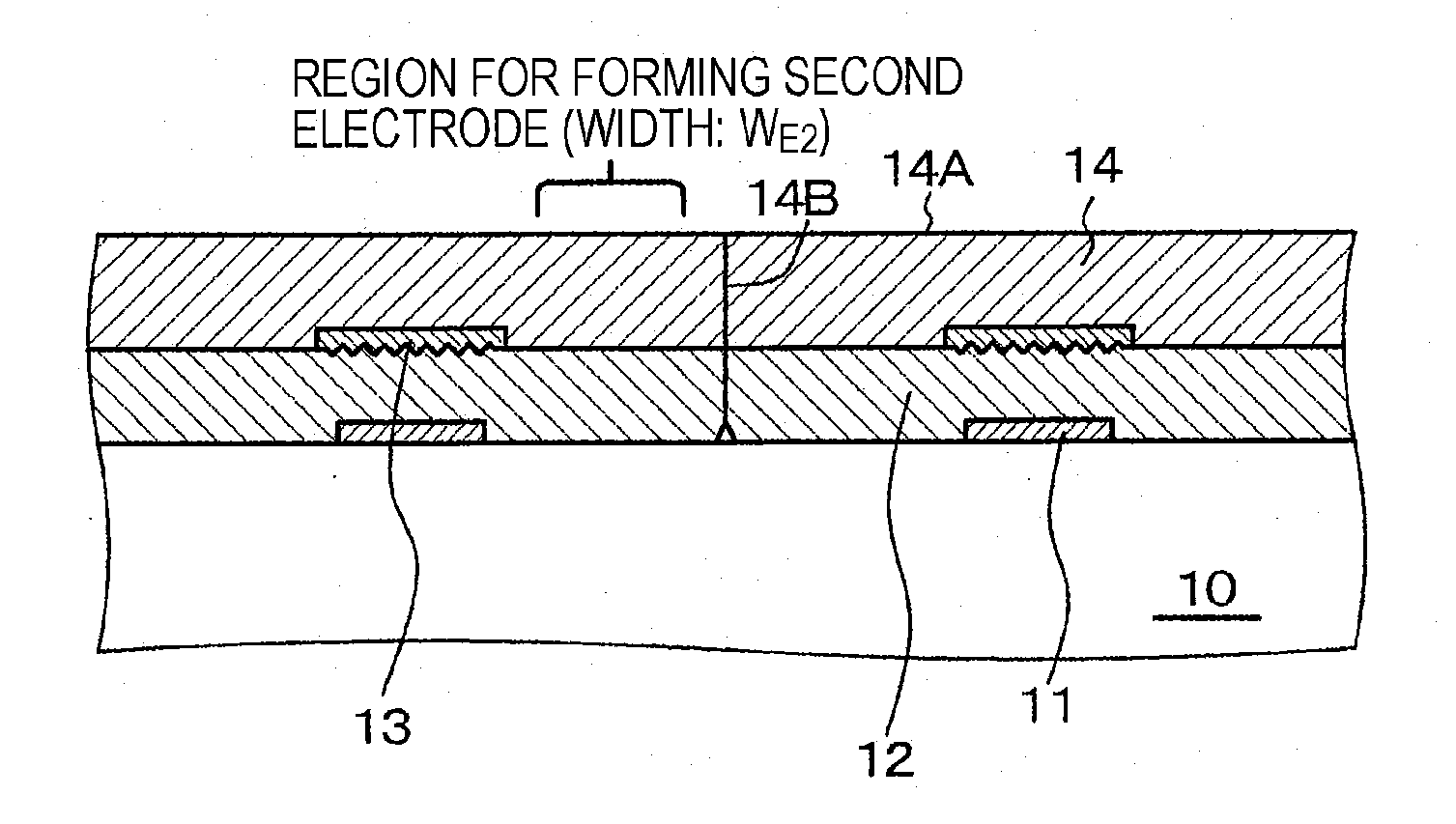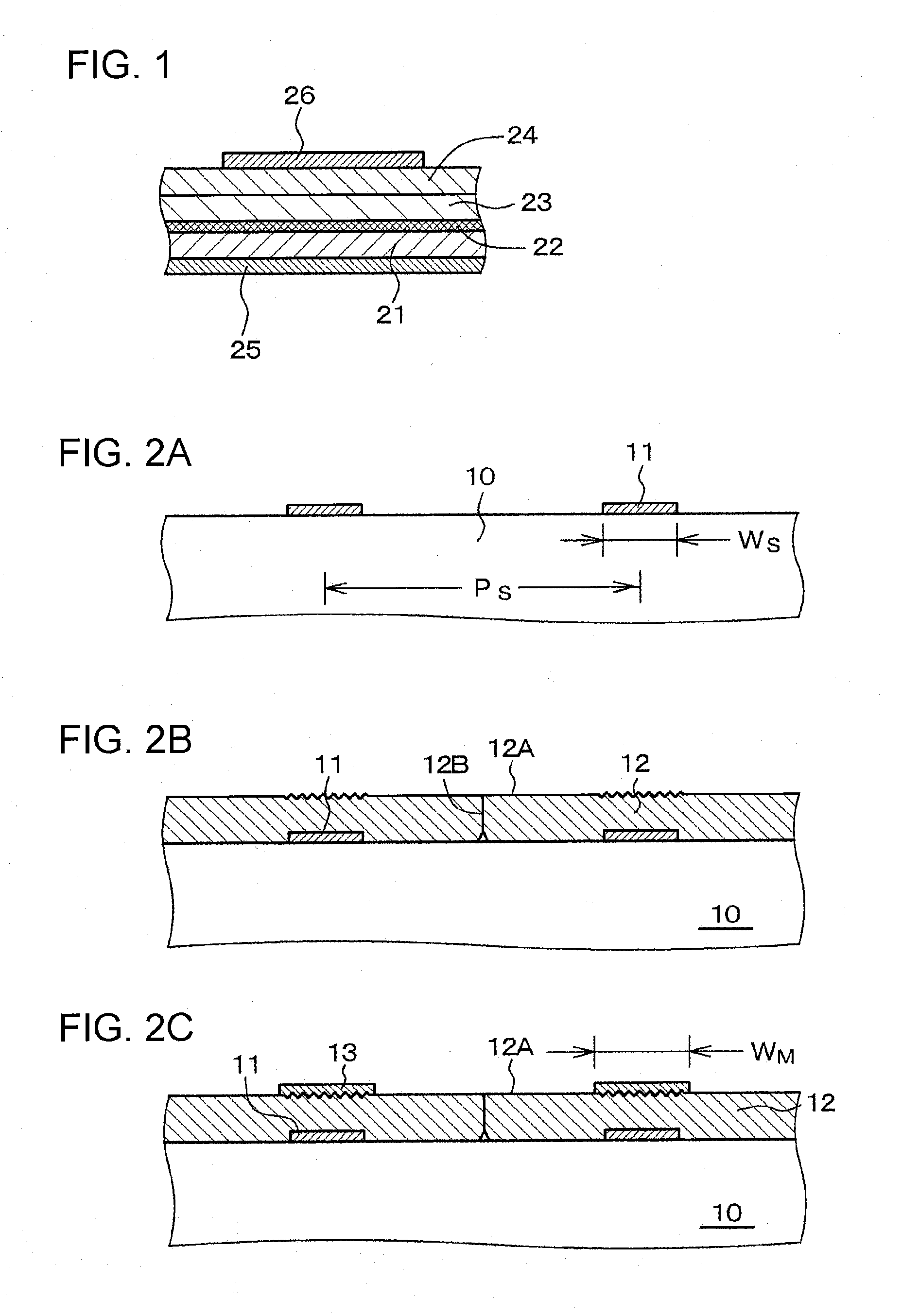Gan-Based Light-Emitting Element and Method for Producing Same
a technology of light-emitting elements and gan-based compound semiconductor layers, which is applied in the direction of semiconductor/solid-state device manufacturing, semiconductor devices, electrical devices, etc., can solve the problems of increasing operating voltage, reducing luminous efficiency, and saturation of luminance, so as to prevent the occurrence of phenomena, reduce the crystal defect density, and reduce the resulting crystal defect density
- Summary
- Abstract
- Description
- Claims
- Application Information
AI Technical Summary
Benefits of technology
Problems solved by technology
Method used
Image
Examples
first embodiment
[0094] A first embodiment relates to a GaN-based semiconductor light-emitting element according to a first aspect and a third aspect of the present invention. Furthermore, the first embodiment relates to a method for producing the GaN-based semiconductor light-emitting element according to the first aspect of the present invention. FIG. 1 is a schematic cross-sectional view of the GaN-based semiconductor light-emitting element, more specifically, a light-emitting diode (LED) according to the first embodiment.
[0095] The GaN-based semiconductor light-emitting element according to the first embodiment has a structure in which a first GaN-based compound semiconductor layer 21, an active layer 22, a second GaN-based compound semiconductor layer 23, and a contact layer 24 are stacked. The top face of the first GaN-based compound semiconductor layer 21 is parallel to the a-plane or a nonpolar plane and has a first conductivity type (specifically, n-type). The active layer 22 is disposed o...
second embodiment
[0120] A second embodiment is the modification of the first embodiment.
[0121] In the first embodiment, lateral epitaxial growth of the first underlying GaN-based compound semiconductor layers 12 is stopped when opposite side faces 12B of adjacent first underlying GaN-based compound semiconductor layers 12 come into contact with each other. In a GaN compound semiconductor crystal, the coefficient of thermal expansion in the c-axis direction is extremely smaller than the coefficient of thermal expansion of a sapphire substrate. Consequently, the seed layers 11 and the first underlying GaN-based compound semiconductor layers 12 may be detached from the sapphire substrate 10 due to a large change in temperature.
[0122] In second embodiment, in a step similar to [Step-110] in the first embodiment, first underlying GaN-based compound semiconductor layers 12 are formed by lateral epitaxial growth from seed layers 11. The lateral epitaxial growth is stopped before opposite side faces 12B o...
third embodiment
[0137] A third embodiment is the modification of the second embodiment. A main difference between the third embodiment and the second embodiment is the film-forming conditions when the first underlying GaN-based compound semiconductor layers 12 are formed by lateral epitaxial growth from the seed layers 11. In particular, the difference is an increased flow rate of the nitrogen source gas.
[0138] [Step-300]
[0139] The plurality of seed layers 11 that are composed of a GaN-based compound semiconductor and that are apart from each other are formed on the r-plane of a sapphire substrate 10 in the same way as in [Step-100] in the first embodiment. In the third embodiment,
WS=6 μm; and
PS=24 μm.
[0140] [Step-310]
[0141] First underlying GaN-based compound semiconductor layers 12 each having the top face 12A parallel to the m-plane and each having a side face 12B parallel to the c-plane are formed by lateral epitaxial growth from the seed layers 11 in the same way as in [Step-210] in the se...
PUM
 Login to View More
Login to View More Abstract
Description
Claims
Application Information
 Login to View More
Login to View More - R&D
- Intellectual Property
- Life Sciences
- Materials
- Tech Scout
- Unparalleled Data Quality
- Higher Quality Content
- 60% Fewer Hallucinations
Browse by: Latest US Patents, China's latest patents, Technical Efficacy Thesaurus, Application Domain, Technology Topic, Popular Technical Reports.
© 2025 PatSnap. All rights reserved.Legal|Privacy policy|Modern Slavery Act Transparency Statement|Sitemap|About US| Contact US: help@patsnap.com



